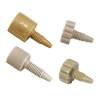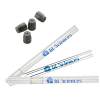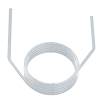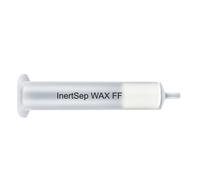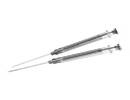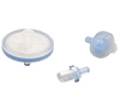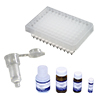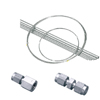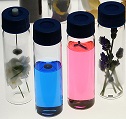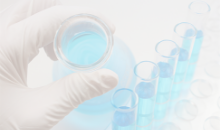5. How to Improve Sensitivity
Detection sensitivity in HPLC depends mainly on the type of detector. However, it is also influenced by some other factors. This section describes how to improve sensitivity.
5-1. Increasing the Injection Volume
Dirt in the column distorts peak shapes. In this case, please try column wash first. For example for reversed-phase columns, follow the flowchart on the right. Methanol and acetonitrile are generally used solvents in the washing process, but if the dirt cannot be washed out, 2-propanol or acid-containing organic solvents may remove it. If dirt accumulation often happens, the use of a guard column is recommended. It is sometimes effective to remove sample matrix by pre-Sensitivity can be improved by increasing the injection volume because the increased amount of analytes. However, note that some solvents might distort peak shapes. See also Figure 1-9 in Chapter 1.

5-2. Suppressing Background Noise
Quantification of low concentration samples becomes difficult when the background level is high around the elution of the target compound because of the large baseline noise. Sensitivity can be enhanced by adopting conditions which keep the background level as low as possible.
For UV detectors
Some salts for buffer has UV absorbance. Because of this, for example, phosphate buffers are preferred to acetate buffers or format buffers for detection at 210 nm. This is also the case for organic solvents. Be careful about the kind and the grade of the organic solvent you use.

For fluorescent detectors
When the excitation wavelength (Ex) and the emission wavelength (Em) are close, Raman scattered light of the mobile phase may also be detected. This increases the background value and the baseline noise.
For mass spectrometers (MS)
When the mobile phase contains a lot of nonvolatile salts or solvents, the ionization efficiency decreases, resulting in poor detection sensitivity. Therefore, the detection sensitivity can be improved by using columns that provide good peak shapes even at low salt concentrations, or by selecting separation modes that allow the concentration of methanol or acetonitrile in the mobile phase to be as high as possible when the target compound elutes from the column. We also recommend regular maintenance because the sensitivity gets lower as dirt accumulates in the ion source.
5-3. Changing the Response of the Detector
For many detectors, a value of response can be set. Low response values enable precise detection of sharp peaks, but the background noise become large at the same time. On the other hand, high response values lower the background noise as well as the intensities of sharp peaks. Therefore, it is important to select a proper response value.

5-4. Reduction of Sample Adsorption on Vessels
Adsorption of the target compound on inner walls of sample vessels like vials decreases the sample concentration injected to the system. As a consequence, the amount of the target compound reaching the detector is reduced. For example, silanol groups in glass adsorb basic compounds, while plastics adsorb hydrophobic compounds. Choose a proper material for your sample vessels, depending on your target compound.



